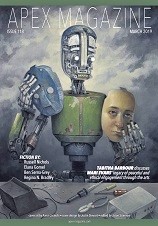“The Prison-House of Language” by Elana Gomel
Reviewed by Victoria Silverwolf
Three new short stories and one original novelette appear in this month’s issue, along with interviews and non-fiction.
The narrator of “The Prison-House of Language” by Elana Gomel was born with a genetic disorder that causes her to experience speaking as physical pain. Despite, or possibly because of, this problem, she becomes a brilliant linguist, with the ability to learn a new language in a few days. She accepts an assignment to investigate the results of a bizarre experiment. Political refugees, euphemistically termed volunteers, underwent surgical procedures to remove their ability to use language. They begin speaking in ways completely unrelated to any human tongue. Solving the mystery leads the protagonist to examine her past.
There is much more to this story than indicated above. The author manages to weave together many themes from science fiction in a coherent way, while creating an intriguing main character. The plot advances in unexpected ways, leading to a final revelation that invokes the sense of wonder.
“When Gods Dance” by Ben Serna-Grey is a very short, surreal tale narrated by a parent mourning for a dead son. The narrator brings several beings to life from objects used by the child. The litany of these invocations, made from glass, toys, sand, and other simple materials, ends with a final sacrifice by the narrator.
The author powerfully conveys parental guilt and grief. The climactic scene has emotional appeal, but is difficult to interpret.
“Curse Like a Savior” by Russell Nichols is set at a time in the future when people have holographic replicas of great figures from the past in their homes. Computer hackers vandalize these simulacra, changing famous quotes into obscene, racist, and blasphemous statements. The protagonist is a technician who repairs the damaged holograms. While on a house call to fix a profanity-spewing image of Jesus, he discovers that his client has more in mind for him than expected.
This story examines the nature of religious belief in a satiric way. Written in an informal, sardonic style, with an ironic ending, some readers may find it a little too clever for its own good. Others will appreciate its smart aleck attitude.
The issue’s longest piece is “O Have You Seen the Devle with his Mikerscope and Scapul?” by Jonathan L. Howard. The narrator sees the murders of Jack the Ripper, but is helpless to prevent them. At first, it seems that we might be reading the observations of a person viewing the past from the future. Later, the narrative appears to be someone watching the killings in imagination only. At the end, the story adds an element of fantasy, resulting in a sort of justice for the infamous murderer.
The bulk of this story consists of detailed descriptions of the Ripper’s slayings. Although vividly written, these are overly familiar to anyone knowledgeable about the case. The reader may find the ending cathartic, or disturbing.
Victoria Silverwolf is trying to remember to set the clocks one hour forward this weekend.
 Apex #118, March 2019
Apex #118, March 2019